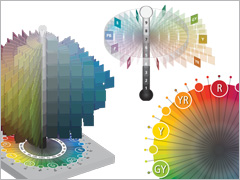
Through the development of Munsell color space, A.H. Munsell kept color education at the forefront of his work. So in 1902, with much of his color theory developed, he began to consider tools that would facilitate teaching the Munsell color space to children in grades 1-9. He had already developed the color research and was exploring additional tools such as a color sphere, which was the precursor to today’s Munsell color tree and color plates, which represent the predecessors to today’s Hue Value Chroma Charts.
Turn of the Century Color Education: Munsell Color Space (Circa 1902)
In his diary, Albert Munsell describes working with Miss Peterson, who was the superintendent of Drawing for Boston Schools—clearly art education in the early 1900’s was an important part of the teaching curriculum. There didn’t appear to be a good method for teaching children about color and Munsell aimed to change that with his teaching aids and the help of a publisher. Munsell’s diary describes the challenge of teaching color to school children as follows, “No teacher understands the subject of color, but everybody has interest in it. It is now THE subject uppermost.”
Munsell Color Space Believed to Cross a Chasm between Art and Science
As Munsell pursues how best to teach color, he continues to consult with scientific authorities to ensure that his work was grounded in scientific principles. On April 8 1902, Munsell describes a meeting with Professor Dolbear (believed to be Amos Dolbear, who served as Tufts University astronomy and physics professor and a pioneer of telephony). Munsell quotes Dolbear, “Says I may furnish a track across what is now a desert between practical and scientific color work.”
Returning to art and the practicality of his color work, Munsell finds references to the book Music and Musicians, which he used to suggest potential names for what would later become A Color Notation. In particular, Munsell fancied the book’s section titles, “A Study of Musical Sound,” “The Materials of Sound,” “Grammar of Music,” and “Esthetics,” from which he considered the following for his book of color: “Grammar of Color,” Esthetics of Color,” and “Materials of Color.”
Munsell Color Space: Teaching the Teacher
Munsell continued to work with science and academia on his book of color. However, in the meantime, and with the help of Miss Peterson, Munsell developed “The Munsell Color System,” a simple teachers’ handbook arranged for primary and grammar school teachers. The handbook included a review of color names that children learn in Kindergarten (red, yellow, green, etc.) along with what appeared to be rudimentary color charts to teach children how to order color. Of course Munsell’s hue, value and chroma attributes were taught early on in the curriculum as was the value scale. Munsell’s color sphere was an important teaching aid. The tools used to teach Munsell Color Space—color charts, color sphere and neutral value chart—remain staples in today’s Munsell Interactive Learning Kit. Learn more about Munsell Color Space.
References:
- H. Munsell Color Diary, 1908-1918, Volume A Part 8. Courtesy of Rochester Institute of Technology, Munsell Color Science Library.



Leave a Reply